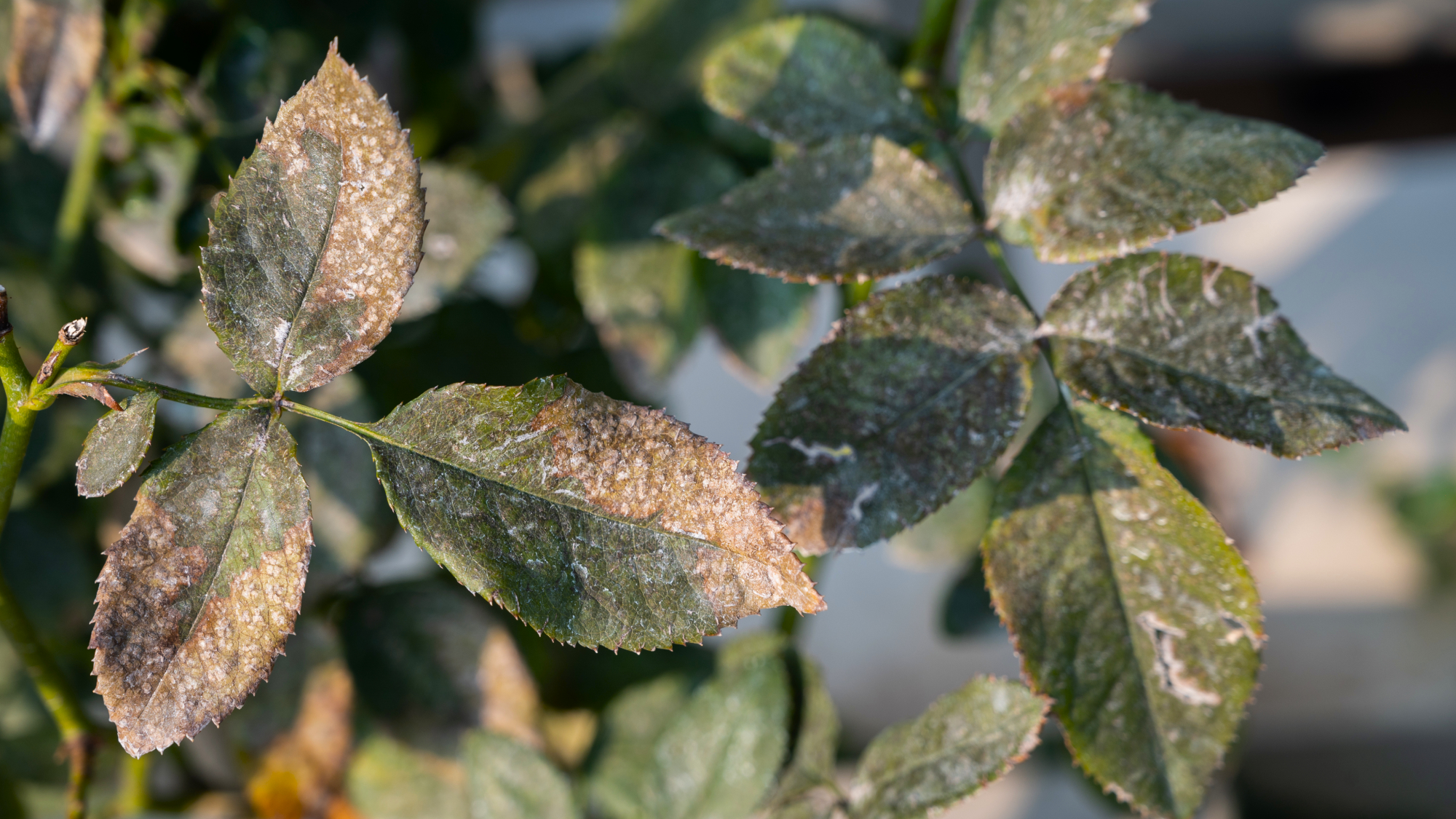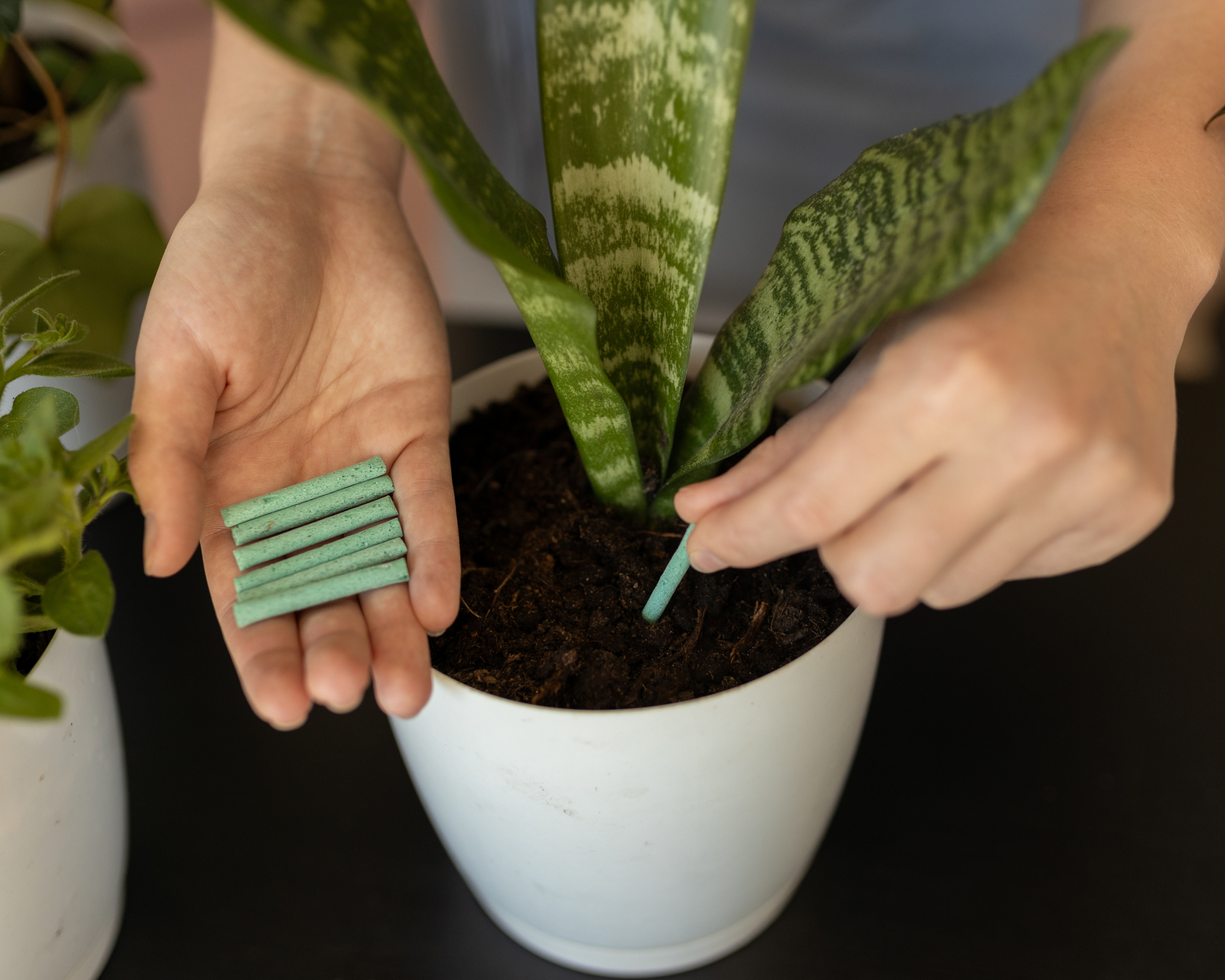Powdery Mildew Ruining Your Indoor Plants? Here Are the 6 Most Common Causes & How to Solve Them for Healthy Houseplants
Don't worry if you discover powdery on the indoor plants in your collection! Here's how to treat it and prevent this common problem from coming back.

Laura Walters

Powdery mildew on indoor plants isn’t as common as on those grown outdoors, but it does occur. It may appear as white spots on houseplants. The most obvious symptom is powdery lesions that look as if they were dusted with talcum powder.
But it's definitely not talcum powder. That white chalky stuff on your plants is a fungus and it needs to be dealt with quickly as it can spread easily. It occurs most often when conditions are warm and wet. And it's one of the most common houseplant diseases.
Understanding all the causes of powdery mildew on houseplants and how to prevent them is the first step to treating the problem. I’ll walk you through why powdery mildew affects houseplants, how to avoid it, and how to get rid of powdery mildew that is already plaguing your precious indoor plants.
What Is Powdery Mildew?
Powdery mildew on houseplants is a fungal disease. It comes from any fungus in the genera Erysiphe, Sphaerotheca, or Podosphaera.
Powdery mildew typically affects plants outdoors, but it can spread easily indoors as well. Inside your home or greenhouse, powdery mildew requires temperatures around 70°F (21°C) to develop and spread. It occurs when there is poor air circulation and low light, but unlike outdoor powdery mildew, indoor fungi thrive in drier conditions.
Mycelium formed from the fungal spores is the source of the fluffy white stuff on your houseplant foliage. The spores spread in the air and when water splashes onto plants. Powdery mildew control is essential in the home due to this aggressive, contagious behavior.

Common Symptoms
Houseplants can get powdery mildew at any time of the year, so always be on the lookout for the symptoms. It is important to inspect plants and start treatment immediately to avoid spreading the disease.
Sign up for the Gardening Know How newsletter today and receive a free copy of our e-book "How to Grow Delicious Tomatoes".
Initially, powdery mildew produces tiny white spots. But the fungus will spread and create large white patches. As the disease spreads, the entire plant can be affected with the fluffy white fungus. Over time, the leaves will twist and deform, then flowers and buds will discolor and become dwarfed.
Eventually, leaves will drop and flower buds will fail to open and fall off. Foliage loss will limit photosynthesis and the overall well-being of your houseplant. Powdery mildew is very contagious and, once one part of the plant is affected, it will infect the rest if left untreated.
Lesions can occur on either the top or underside of the leaves, on flowers and buds, and basically any vegetative surface. It starts out as faint, circular spots of a dusty white material. The spots can be rubbed off by hand, but do not do this as it can spread the disease.

What Causes Powdery Mildew on Indoor Plants?
So now we know what powdery mildew looks like and how it can negatively impact your houseplants. Let’s take a look at the most common causes of this disease.
1. Susceptible Species
Powdery mildew affects several common indoor plant species, though it doesn’t impact them all. This disease doesn’t cause problems for tropical plants or rainforest plants – which includes many houseplants – because these species are adapted to warm, wet, humid conditions.
However, powdery mildew does affect other common indoor flora. Begonias, kalanchoe, African violets, jade plants, and ivy are the most prevalent species with this problem. If you’re worried about powdery mildew on your indoor plants, avoid these species and grow a tropical plant that’s adapted to warmth and humidity instead.
2. Too Much Humidity

Excess moisture, either on the plant material or in the air, is the most common cause of powdery mildew. The spores of this fungus seek out favorable conditions and can germinate in less than two hours.
New crops of spores are produced every 5-10 days where humidity is 97-99%. In areas with high humidity and poor circulation, the fungus can explode. Use a dehumidifier, like this one from Amazon, if you think you need to reduce the humidity in your home.
3. Not Enough Air Flow
Lack of air flow and crowded plants will trap humidity and powdery mildew spores, providing fungi with ideal conditions.
Space plants farther apart so air can move between them. Dense or big-leafed plants may also benefit from some judicious pruning to let air penetrate to the center.
4. Overhead Watering

Allowing water to sit on foliage and buds can cause many types of fungi to flourish. In the case of powdery mildew, such moist conditions form a breeding ground for the disease. Fungal spores also adhere easily to damp leaves and begin to germinate and spread quickly.
Use bottom watering instead of overhead watering to prevent fungus growth. If you want to continue using overhead watering, use a watering can with a long spout that lets you direct where the water goes. This petite and stylish indoor watering can from Amazon is ideal.
5. Not Enough Light
Plants in low light or almost complete shade will dry off much more slowly than those in bright light. Wet leaves equal powdery mildew. If your plant needs low light, provide a fan to increase air circulation and promote drying.
6. Too Much Fertilizer

Over fertilizing houseplants with products that are high in nitrogen promotes fungus. Powdery mildew often attacks buds and new shoots first. So high nitrogen fertilizers promote new vegetative growth that cannot withstand the fungus. Take a break from fertilizing if you start to notice powdery mildew on indoor plants.
How to Get Rid of Powdery Mildew on Houseplants
There are two main ways to control the spread of powdery mildew on indoor plants: cultural and chemical control. I’ll break down both methods to help you decide which one is the best course of action for your impacted plants.
Cultural Control Methods
Make sure plants have enough light, air circulation, and avoid over fertilizing to prevent powdery mildew. Set up a fan, like this affordable fan from Amazon that can clip onto a tabletop, to improve air circulation around plants.
If possible, lower the humidity in the room as well. Always avoid watering plants overhead and do not mist leaves. For smaller infestations, pluck off infected foliage and isolate the plant. Remove any dropped leaves from the surface of the soil to prevent spreading the disease.

Chemical Control Methods
If powdery mildew is present on many of your indoor plants or is very severe and cultural control is not effective, then it may be time to advance to chemical control.
First, start by trying to make a natural, homemade fungicide with a few common household ingredients. It's easy to do and often very effective.
DIY Fungicide Recipes
First, water the plants well from underneath the foliage. Next apply a spray of 1 tablespoon (15 mL) baking soda, 1/2 teaspoon (2.5 mL) liquid dish soap, and 1 gallon (3.8 L) of water. You may also add 1 tablespoon (15 mL) of horticultural oil to help the mixture adhere to the fungus.
Apply this mixture to the top and bottom of the foliage, making sure to wet all the diseased areas. Using this powdery mildew control indoors is safe and non-toxic.
Another organic method to try is a milk spray. Use organic milk that is free of hormones and preservatives. Mix one part organic milk with nine parts water and spray once per week on all affected surfaces of the plant. Provide adequate ventilation while the spray dries to prevent mold.
Another organic option is to try neem oil, like Captain Jack’s from Bonide. It can also help with a whole host of other common houseplant problems.
When all else fails, you can try a commercial fungicide specifically designed for indoor plants, like this fungicide concentrate that you mix with water from Amazon. But always read the label carefully before use and apply as the product is intended. It's best to apply any fungicidal spray outside to prevent drift of the particles inside your home.

Bonnie Grant is a professional landscaper with a Certification in Urban Gardening. She has been gardening and writing for 15 years. A former professional chef, she has a passion for edible landscaping.
- Laura WaltersContent Editor